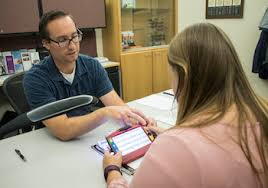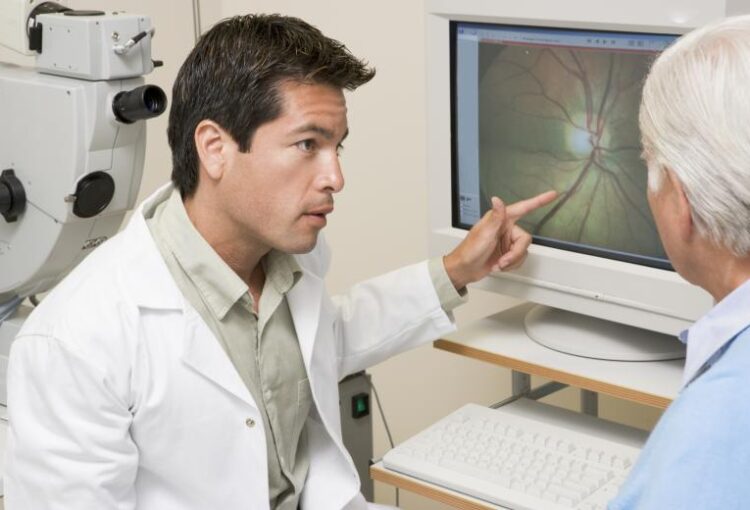
 WHAT IS LOW VISION?
WHAT IS LOW VISION?
Low vision is the term used to refer to a visual impairment that is not correctable through surgery, pharmaceuticals, glasses or contact lenses. It is often characterized by partial sight, such as blurred vision, blind spots or tunnel vision, but also includes legal blindness.
Many newly diagnosed people are referred to us for a low vision evaluation by a low vision specialist.
The Low Vision Specialist uses functional vision evaluation instruments to assess visual acuity, visual fields, contrast sensitivity function, color vision, stereopsis, visual perceptual and visual motor functioning, literacy skills in reading and writing, etc. as they relate to vision impairment and disability. They also evaluate work history, educational performance, use of technology, quality of life and aspects of psychosocial and cognitive function to determine which adaptive aids and improve the quality of life for the visually impaired.
 Low Vision Evaluation
Low Vision Evaluation
WHAT IS A LOW VISION EVALUATION?
The definition of low vision varies. One definition is visual acuity of 20/70 or worse in the better-seeing eye that is not correctable with eyeglasses. Measurement of 20/70 vision means that a person with unimpaired vision can see the chart from 70 feet away, whereas a person with low vision would have to stand closer at 20 feet. Another definition of low vision is uncorrectable vision loss that interferes with one’s daily activities. This definition is useful because often a visit to the low-vision specialist will focus on ways to improve the patient’s independence and quality of life.
A clinical low vision evaluation assesses whether or not a child will benefit from optical devices such as monocular telescopes and/or magnifiers. An optometrist or ophthalmologist who specializes in low vision and the prescription of optical devices performs the clinical low vision evaluation.
ASSISTIVE TECHNOLOGY TO HELP LOW VISION
Advance Spectacle or Head-mounted Magnifiers
This type of low vision assistive device combines the increased magnification of microscopic view lenses, and a specialized head apparatus for securing the lenses before your eyes. This may be a useful low vision aid for hobbies, reading, and other close-up visual tasks.
Handheld Magnifiers
Smaller in size, designed to fit comfortably in your hand, the handheld magnifier can be as simple as the traditional magnifying glass and as advance as an electronic low vision magnifier. Models and manufacturers differ on the size, weight, function, and features available, however the electric handheld magnifier is generally designed to be used with ease and provide multiple magnification strengths. This category of low vision assistive devices offers great visual support for individuals with an on-the-go lifestyle.
Portable Electronic Magnifiers
Perhaps among the most versatile (personal to professional life) low vision assistive devices, the portable electronic magnifiers are able to cover a wide variety of tasks. Some portable electronic magnifiers are extremely lightweight and can be used in the home or in the office. These devices are often capable of being positioned in various directions allowing for information across the room to be gathered clearly and displayed on the personal monitor for enhanced viewing. The ability to adjust the camera (responsible for gathering the images or text) may also be self-directed to provide mirror image viewing, helpful when applying make-up or shaving. Beyond the ease of portability and flexibility, some portable electronic magnifiers offer increased option through viewing modes, adding features like contrast, magnification, computer connectivity and more.
Desktop Magnifiers
Desktop magnifiers, also called CCTV (closed circuit television) magnifiers are more stationary magnifiers. Providing some of the highest levels of magnification power (depending on model and manufacturer), viewing mode options, along with other features, makes these desktop low vision assistive devices more than just an aid for reading.
Fayette County Association for the Blind is Awarded AER Accreditation
 Fayette County Association for the Blind has earned the Fayette County Association for the Blind has earned the distinction “AER Accredited” by the Association for Education and Rehabilitation of the Blind and Visually Impaired (AER).
Fayette County Association for the Blind has earned the Fayette County Association for the Blind has earned the distinction “AER Accredited” by the Association for Education and Rehabilitation of the Blind and Visually Impaired (AER).
This accreditation distinction is awarded to organizations that provide high quality services and support to individuals who are blind or have low vision. In addition, the services must be provided under the most effective administrative and management standards. It signals accountability, results and high merit. The AER Accreditation Program has two fundamental purposes: to validate the quality of an organization and its programs and to assist in the improvement of the organization and its programs. It is a rigorous process aimed at ensuring that optimal gains are achieved for individuals with vision loss. AER’s evaluation of Fayette County Association for the Blind includes a thorough review of the physical facility and quality of client services and programs. AER interviews both staff and clients and conducts a review of organizational documents.
Fayette County Association for the Blind constantly seeks to provide a variety of comprehensive services intended to help people of all ages strive to learn skills and participate in programs that foster ever increasing independence, enabling those with vision loss to continue to be active and contributing in family and community life. Our goal is to be recognized as the county’s key resource and major provider of service to people with vision loss. Founded in 1946, Fayette County Association for the Blind is dedicated to improving the quality of the life for the county’s vision impaired population. AER encourages facilities to meet or exceed quality standards through accreditation and the teaching of quality improvement concepts.
“We are extremely pleased to have achieved this designation,” states Executive Director, Sandra Morris, “Accreditation is a rigorous process, but one that we welcome as a continual quality improvement mechanism. Earning AER accreditation is another measure of our excellence as a premier provider of care and programs for the visually impaired, and it reflects our commitment to our clients.”
AER is a not-for-profit organization dedicated exclusively to professionals who provide services to individuals with vision loss. Grounded in the belief that persons with vision loss should have optimal chances to live independently, AER promotes and supports the field by advocating for evidence-based practices, high quality standards, value added resources and giving voice to issues of critical importance. Since its inception, AER has had one primary purpose and that is to elevate the conditions that drive to excellence. Supporting professionals who deliver services, AER recognizes the role standards play in achieving short and long term goals. To learn more about AER and the accreditation program, send an email to accreditation@aerbvi.org.
For information about the Fayette County Association for the Blind, or if you need services—or if you know someone who needs services—please visit http://fayetteblindassociation.org, email ksims@fayetteblindassociation.org or call 724-437-2791. stinction “AER Accredited” by the Association for Education and Rehabilitation of the Blind and Visually Impaired (AER).
This accreditation distinction is awarded to organizations that provide high quality services and support to individuals who are blind or have low vision. In addition, the services must be provided under the most effective administrative and management standards. It signals accountability, results and high merit. The AER Accreditation Program has two fundamental purposes: to validate the quality of an organization and its programs and to assist in the improvement of the organization and its programs. It is a rigorous process aimed at ensuring that optimal gains are achieved for individuals with vision loss. AER’s evaluation of Fayette County Association for the Blind includes a thorough review of the physical facility and quality of client services and programs. AER interviews both staff and clients and conducts a review of organizational documents.
Fayette County Association for the Blind constantly seeks to provide a variety of comprehensive services intended to help people of all ages strive to learn skills and participate in programs that foster ever increasing independence, enabling those with vision loss to continue to be active and contributing in family and community life. Our goal is to be recognized as the county’s key resource and major provider of service to people with vision loss. Founded in 1946, Fayette County Association for the Blind is dedicated to improving the quality of the life for the county’s vision impaired population. AER encourages facilities to meet or exceed quality standards through accreditation and the teaching of quality improvement concepts.
“We are extremely pleased to have achieved this designation,” states Executive Director, Sandra Morris, “Accreditation is a rigorous process, but one that we welcome as a continual quality improvement mechanism. Earning AER accreditation is another measure of our excellence as a premier provider of care and programs for the visually impaired, and it reflects our commitment to our clients.”
AER is a not-for-profit organization dedicated exclusively to professionals who provide services to individuals with vision loss. Grounded in the belief that persons with vision loss should have optimal chances to live independently, AER promotes and supports the field by advocating for evidence-based practices, high quality standards, value added resources and giving voice to issues of critical importance. Since its inception, AER has had one primary purpose and that is to elevate the conditions that drive to excellence. Supporting professionals who deliver services, AER recognizes the role standards play in achieving short and long term goals. To learn more about AER and the accreditation program, send an email to accreditation@aerbvi.org.
For information about the Fayette County Association for the Blind, or if you need services—or if you know someone who needs services—please visit http://fayetteblindassociation.org, email ksims@fayetteblindassociation.org or call 724-437-2791.
